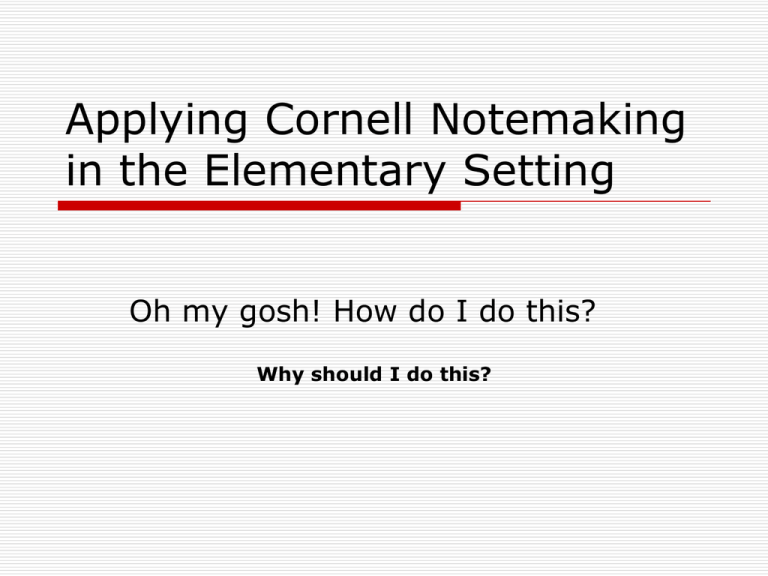Applying Cornell Notemaking in the Elementary Setting
advertisement

Applying Cornell Notemaking in the Elementary Setting Oh my gosh! How do I do this? Why should I do this? Wait a minute! Taking Notes? Notemaking is most often thought of in a secondary of higher educational environment. This does not mean it can’t be done at the elementary level. Notes should be used to help students learn and recall information. Even the youngest student can do this. Note taking The student hears what the teacher says and writes it down. The student writes down the material for study. The student studies the notes to prepare for assessments. Notemaking The student takes information from lecture, curriculum, and classroom experience and puts it into their notes. The student writes the notes in ways that are meaningful to them (i.e. written word, drawings). The information is used in classroom and small group discussions. The student constantly builds on the notes by adding further information learned, building schema, and connecting information. The student constantly studies the material because further material draws on concepts already learned. The Cornell Notemaking System Traditional Cornell Notes Title Box Cue Column Notemaking Column Summary Box Further Questions Box The Keys to Success 1)You must be patient. Like all skills and procedures we teach throughout the year, this will take some time to learn. However, if used consistently students will become comfortable with the system and integrate it into their everyday activities. 2) Some assembly required! The Cornell system can be better taught at the elementary level using scaffolding methods that gradually transfer over to true Cornell notes. 3) Do as I do. Cornell notes will take more quickly if the teacher does them with the students initially. Stages of efficient notemaking The beginning format -Teacher driven(cues and questions are written by teacher) -Heavy Scaffolding and Guidance (“Let’s add this piece of information.”, or “This is a great diagram, let’s copy it.”) -Done in a group format (i.e. through discussion, the group decides what should be written on the page) Stages of efficient notemaking The intermediate format - Teacher and Student Driven (Cues and questions are given, but students have the freedom to add their own.) - Moderate scaffolding (students begin to learn their notemaking style and copy notes in their notebooks during class discussion.) - Done in group discussion or on an individual basis Stages of efficient notemaking The advanced stage - Student driven (No questions or cues are given. Instead the students fill those in at the end.) -Freedom of choice. Students decide what information becomes a part of their notes. - Minimal scaffolding required/ peer to peer scaffolding (students bounce ideas off of each other during group share times.) Bringing it all together- What a notebook should look like Include a table of contentsThis enables the student to quickly find past notes for review. Each entry should include a title for a set of notes, its page number, and its date. Number your pagesTo go with the above point, number your pages for easier retrieval of past notes. Write on the fronts of pages onlyThis enables students to come back and input additional information on a topic later if a connection is made. Benefits for Elementary Teachers Notes can help foster group discussions on a topic. As each child values various information to varying degrees, many points of view are shared. Students benefit from “think tank” style idea sharing. This allows students to draw upon each other’s knowledge to gain a comprehensive view of a topic. Notemaking is no longer a drill and practice retelling of facts. Notes allow students to review concepts for upcoming assessments. Notes organized in an orderly structure allow students to link ideas, build schema, and use prior knowledge to aid them in future notemaking experiences. Uniformity v. Creativity and Sense-making v. Fact Reporting The Cornell system of notemaking is a flexible system for making notes on any topic. The key to its flexibility lies in the fact that each notemaker uses methods that are comfortable to them. As teachers, we need not adhere to some rigid structure that all students must follow, but instead should encourage students to work within the flexible structure to find a method that is meaningful to them. This ultimately yields a learner who uses the system to make sense of reading and learning experiences instead of copying them down for the purpose of regurgitating facts. Acknowledgments Cornell University, Center for Learning and Teaching Dr. Robert Foster, Assistant Professor of Christian Ministries, Williams Baptist College





